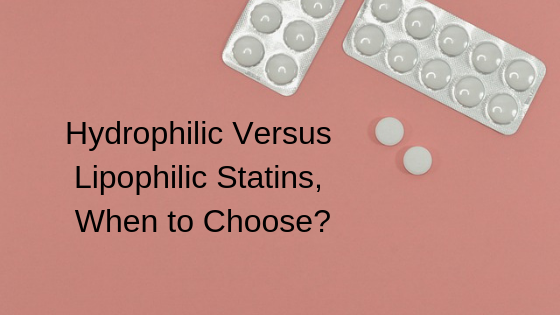Statins are one of the most commonly prescribed medications to help reduce cholesterol and reduce the risk of cardiovascular events like heart attack and stroke. I’ve been asked the question a few different times about why we should choose a hydrophilic versus a lipophilic statin.
In general, lipophilic drugs tend to penetrate into the body to a much greater extent. Of highest importance is penetration into the CNS (brain). CNS side effects are possible with statins but are not common in my experience.
Hydrophilic statins tend to have less central nervous system penetration. Here’s a list of common statins and which ones have certain tendencies.
Hydrophilic Statins
- Rosuvastatin
- Pravastatin
Lipophilic Statins
- Atorvastatin
- Simvastatin
- Lovastatin
- Fluvastatin
As above, there is a long list of statins now available. In most circumstances, it is advisable to choose a statin that has a high potency potential (can cause a big drop in cholesterol). The two commonly used examples that are high potency are atorvastatin and rosuvastatin.
Choosing a Hydrophilic Versus a Lipophilic Statin – Practice Pearls
To be honest, in most patients, I don’t have a strong opinion on whether to choose a hydrophilic versus a lipophilic statin. In my experience, atorvastatin is used more frequently than rosuvastatin. Most clinicians seem to be more experienced with atorvastatin and likely one of the reasons was cost. It became generic years before rosuvastatin did.
Don’t make it more complicated than it has to be. If a patient initially tried atorvastatin and did not tolerate the medication due to adverse effects, it would be a strong consideration to use a hydrophilic statin like rosuvastatin (or pravastatin if the patient doesn’t need a large amount of cholesterol-lowering effect). In the event of a very severe adverse effect or life-threatening reaction like rhabdomyolysis, a retrial of a statin is likely not a good idea.
As always, there are other pharmacokinetic considerations such a metabolic pathways and drug interactions to be aware of, but a chance at a different risk profile of adverse effects and tolerability is the reason to try a hydrophilic versus a lipophilic statin. It doesn’t always work, but may be worth a shot in certain patients who haven’t tolerated one or the other.
- 30 medication mistakes PDF
- 18+ Page Drug Interaction PDF
- 10 Commandments of Polypharmacy Webinar based on my experiences in clinical practice



Hi Eric
I am Dr. Syed and teaching Pharmacotherapy in Calgary Canada. I have all of your books. Is it possible if I can get the PDF versions of your books like BCPS 2019 and others.
Hi Dr. Syed, thanks for the comment and support! Amazon does not allow me to provide the books as PDF’s as part of our contract to sell on their platform. I am working on having someone get kindle versions of the book which I don’t know if that is helpful for you or not? – thanks so much for reaching out and I will do my best to continue to try to help provide valuable information!
Eric